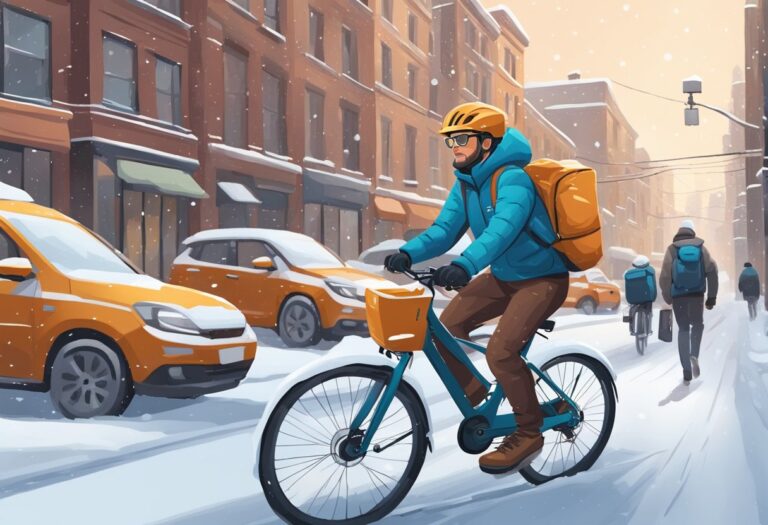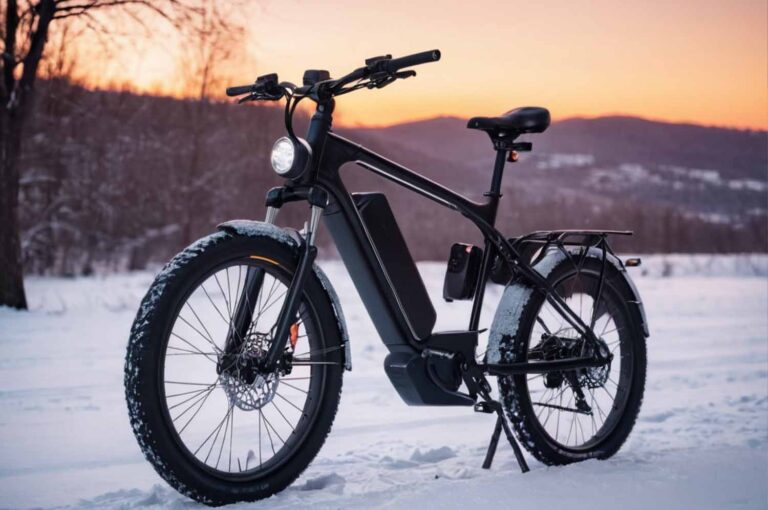Winter E-Biking Insights from an Expert Rider
Winter presents unique challenges and opportunities for cycling enthusiasts, especially those embracing the electric bike revolution. As the mercury drops, roads and trails can transform into icy avenues that demand careful navigation.
E-bike riders need to adapt to the cold weather, not only to maintain performance and safety but also to continue enjoying their rides during the frosty months.
Electric bikes are engineered to tackle diverse conditions, but winter brings with it a distinct set of demands. The battery, being the heart of an e-bike, requires special attention in colder temperatures.
Expert riders and manufacturers alike emphasize the importance of preserving battery life and performance through proper care and maintenance during winter. Additionally, there is a strong focus on personal comfort and safety, with advice on how to dress appropriately and equip your e-bike for icy conditions.
Engaging with a range of winter e-biking enthusiasts and professionals has unearthed a treasure trove of insights. From winterizing your e-bike to understanding the nuances of navigating safely through snow and ice, these conversations capture the essence of what it means to ride electric in the cold. Their experiences form a comprehensive guide that encourages riders to explore winter landscapes with confidence.
Table of Contents
Understanding E-Bike Winterization
Winter brings unique challenges to electric bike enthusiasts, especially when it comes to maintaining battery life and preventing corrosion. A proper approach to winterization can ensure your e-bike remains in peak condition, even in cold temperatures.
E-Bike Storage Tips
Proper storage of your electric bike during winter is crucial. It’s important to store the battery at a moderate temperature to preserve its battery life.
Ideally, the battery should be kept in an environment that is dry and free from extreme cold or heat. Remove the battery from the e-bike if you’re not planning to ride for an extended period.
- Battery Storage Temperature: Keep above 32°F (0°C)
- Charge Level: Store at 30-60% charge to maintain battery health
Winterizing The E-Bike Frame
Winterizing an electric bike frame involves a thorough cleaning to remove any dirt, salt or grime that can cause corrosion. After cleaning, apply a protective layer to the frame to shield it from the elements.
Silicon-based sprays or bike-specific protectants are recommended for this purpose. Pay special attention to the nooks and crannies where water can gather and freeze.
- Clean Frame: Before applying protectant
- Apply Protectant: After cleaning to prevent rust
Drivetrain And Component Maintenance
The drivetrain and other components require regular maintenance during winter riding. This includes lubrication to ensure that parts don’t freeze and to protect against rust.
Select lubricants that are designed for wet conditions to extend their effectiveness throughout the winter months.
- Lubrication Frequency: More often in winter conditions
- Lubricant Type: Wet lubricants for increased protection
Essential Gear For Winter E-Biking
The right gear is crucial for safe and enjoyable e-biking during winter. Selecting suitable tires, managing battery performance, and wearing appropriate clothing are key to tackling the cold.
Choosing The Right Winter Tires
Winter tires are paramount for e-biking in snowy or icy conditions. Studded tires provide extra grip and stability. They come with metal studs that can bite into ice, preventing slips and falls.
It’s important to choose tires with a tread pattern designed for snow and slush, ensuring consistent traction.
- Tire Types:
- Studded
- Knobby for deep snow
- All-season for wet and moderately snowy conditions
Keeping Batteries Warm And Efficient
Cold weather can significantly reduce battery efficiency and range.
Keeping the battery warm is essential. A battery cover can be a simple and effective way to insulate and protect the power source from the cold.
Riders should also store their e-bikes in a warm environment to prevent battery capacity from dropping.
- Battery Care Tips:
- Use a battery cover or insulation
- Store at room temperature
- Keep the battery charged
Protective Clothing And Layering
Wearing the right clothing is critical for comfort and safety while winter e-biking.
One should layer their clothing, starting with a moisture-wicking base layer, typically wool, to keep sweat away from the body.
Insulating layers add warmth, topped with a windproof and waterproof outer layer.
- Clothing Checklist:
- Helmet: Mandatory for safety
- Gloves: Insulated and waterproof
- Boots: Waterproof with a grippy sole
- Scarf or neck gaiter: To protect against wind chill
- Layers: Wool or synthetic base, fleece mid-layer, waterproof outer
Proper attire not only protects from the cold but also from potential injuries due to falls. Riders should not overlook the importance of a helmet with good coverage and insulation, as well as waterproof gloves and boots designed for icy conditions.
Riding Safely In Winter Conditions
Riding an e-bike in winter presents unique challenges requiring special considerations to maintain safety.
Riders must adapt their approach to navigate slippery conditions, ensure they are visible in low-light environments, and modify their riding techniques to tackle the cold-weather elements effectively.
Navigating Snow And Ice
Tires: They are the first line of defense when it comes to maintaining traction on snow and ice. Riders should equip their e-bikes with winter-specific tires that have a deeper tread pattern and are made of a softer rubber compound to grip the road better. For extreme conditions, studded tires can make a significant difference.
- Slush and Ice Handling: Slush can decrease stability, making it important to reduce speed and use brakes cautiously. On ice, sudden movements can lead to loss of control, so riders must keep a steady pace and avoid sharp turns.
Visibility And Lighting
Lighting: Adequate lighting is crucial for winter e-biking. Not only does it help the rider see where they are going, but it also ensures that other road users can see the e-bike.
- Reflective Elements and Lights: Bright and reflective clothing, as well as light-emitting diodes (LEDs) on both the front and back of the e-bike, greatly improve visibility.
Adapting Riding Style To Winter
Riding Style: Winter conditions require adjustments in the way riders handle their e-bikes to stay safe.
- Control and Speed: Riding at a slower speed allows for more reaction time and reduces the risk of accidents. A controlled and upright riding style increases stability, especially when navigating through slush or over ice.
- Braking: Applying brakes should be done gradually to prevent locking up the wheels, which can result in a skid. It’s advisable to use both the front and rear brakes evenly to maintain control.
Maximizing Performance And Safety

When winter arrives, maintaining peak performance and safety on an e-bike requires a focus on tire pressure and traction, protecting the bike from wear and tear, and managing the battery’s charge and range to handle the cold.
Optimizing Tire Pressure And Traction
Appropriate tire pressure is crucial for safety and stability on the icy and slippery roads of winter.
Maintaining a slightly lower tire pressure than in warmer conditions can increase the tire’s contact area, thereby improving traction.
However, it’s essential to stay within the recommended pressure range to prevent pinch flats and rim damage.
For instance, if a tire’s summer pressure range is 35-65 PSI (pounds per square inch), reducing it to near the lower end, say 30-50 PSI can enhance grip without sacrificing tire integrity.
- Recommended Winter Tire Pressure Range: 30-50 PSI (consult specific e-bike manual)
- Purpose: Enhanced traction without compromising tire safety
Protecting Against Wear And Tear
Winter conditions, including the presence of salt on the roads, can accelerate the wear and tear of an e-bike.
To safeguard against this, regular cleaning is imperative to remove corrosive substances like road salt. Pay special attention to the chain, brake systems, and gears.
Applying a winter-grade lubricant can repel water and ensure components remain in good working order.
- Regular Maintenance Checks:
- Clean chain, gears, and brakes
- Apply winter-grade lubricant
- Impact: Preserves brake performance and overall bike longevity
Maintaining Battery Charge And Range
Cold weather can significantly reduce battery capacity and, as a consequence, the e-bike’s range. To combat this, it’s advised to store the battery
in a warm place and only install it before heading out. One should also keep the battery charged above 50% to maintain optimal performance.
Charging the battery after each ride ensures sufficient charge, hence reducing the likelihood of an accident due to sudden loss of power.
- Winter Battery Care:
- Store battery in a warm place when not in use
- Keep the charge above 50%
- Effect on Range: Prevents unexpected range depletion
By following these focused guidelines, riders can enhance e-biking safety and performance during the colder months.
Practical Tips For Everyday Winter E-Biking

Embracing winter e-biking involves more than just braving the cold; it demands meticulous preparation in terms of gear selection, bike maintenance, and route planning to ensure safety and enjoyment.
Effective Cold Weather Gear Choices
Gear Up for the Cold: Dressing appropriately is critical for winter e-biking. Cyclists should opt for layers that can be easily added or removed as needed.
Starting with a moisture-wicking base layer that keeps sweat off the skin, riders should then add an insulating layer, such as fleece, to retain body heat. A waterproof and windproof outer layer will protect against snow and freezing rain.
Hands and feet require special attention; waterproof gloves and thermal socks are essential. For their faces, cyclists can rely on balaclavas to shield against frosty winds.
| Gear Type | Material | Importance |
|---|---|---|
| Base Layer | Moisture-wicking fabrics | Keeps skin dry |
| Insulating Layer | Fleece or synthetic down | Traps body heat |
| Outer Layer | Waterproof, windproof | Guards against elements |
| Gloves and Socks | Waterproof, insulated | Protects extremities |
| Face Protection | Neoprene / Fleece | Shields face from cold |
Routinely Cleaning And Checking The E-bike
Maintain to Sustain: Regular maintenance is crucial to withstand the winter wear and tear that can rapidly degrade an e-bike.
Salt and road grime should be cleaned off after each ride to prevent corrosion, especially on the chain and gears.
Checking the tire pressure and tread before heading out is also important for optimal grip on slippery surfaces.
Charging the battery in a warm environment will help maintain its efficiency. Additionally, it’s wise to perform a weekly check-up to ensure all components are functioning correctly.
Planning Your Route And Adventure
Map Out Your Journey: Navigating winter landscapes safely requires thoughtful planning. Adventurers should always check weather forecasts and condition reports to avoid hazardous situations.
They should plan routes that are well-lit and cleared of snow, taking note of shelter locations along the way in case of sudden weather changes.
Understanding the terrain and potential hazards, like icy patches, is part of a successful e-biking experience. Preparing alternative routes is also recommended, giving riders flexibility to adjust to unforeseen challenges.
Advanced Considerations For Enthusiasts

Seasoned winter e-bikers know that preparing electric bikes for the colder months requires attention to detail and an understanding of how extreme weather affects performance and safety.
This segment delves into the nuances of customizing e-bikes, enhancing their performance, and utilizing accessories to ensure every ride is safe and enjoyable despite the chill.
Customizing E-Bikes For Winter Challenges
Customizing your electric bike for winter conditions starts with selecting the right tires. Fat tires can offer improved traction on snowy and icy roads.
It’s crucial to check the tire pressure regularly since cold temperatures can decrease it, reducing traction.
Upgrading to winter tires specifically designed for cold weather will also make a considerable difference. Here’s a brief comparison:
| Tire Type | Benefits | Considerations |
|---|---|---|
| Fat Tires | – Enhanced stability on slippery surfaces – More comfortable ride over rough, uneven terrain | – Can be more expensive – May require frame adjustments |
| Winter Tires | – Superior traction in snowy conditions – Specialized treads for grip | – Wear out faster if used on regular pavement – Limited styles for certain e-bike models |
Enhancing Electric Bike Performance
To maintain power output and battery care during winter, it’s essential to keep the battery warm and charged. A spare battery can be a lifesaver on longer trips, ensuring you never run out of juice.
Riders should be mindful that the cold can reduce battery efficiency, so planning for decreased range is crucial. Electrical connections should also be checked and protected against moisture to prevent any power issues mid-ride.
Utilizing Accessories For Added Comfort
Maximizing comfort during winter e-biking involves layering with moisture-wicking base layers and a breathable jacket.
High-visibility clothing or accessories with reflective details enhance safety in low-light conditions.
Hands and face are particularly vulnerable, so wearing goggles and using bar mitts ensures protection against the freezing wind. A simple checklist of essential gear can look like this:
- Clothing: Windproof and breathable jacket, moisture-wicking base layers
- Accessories: Goggles, bar mitts, bright lights, reflective clothing
- Spare Parts: Extra battery, patch kit for fat tires
By focusing on improved traction, protective components, and essential gear, riders can navigate winter’s challenges with confidence.
Whether it’s reinforcing electric bikes to handle icy roads or selecting the right kind of clothing to keep warm, each measure contributes to an enjoyable and reliable winter e-biking experience.




Leave a comment